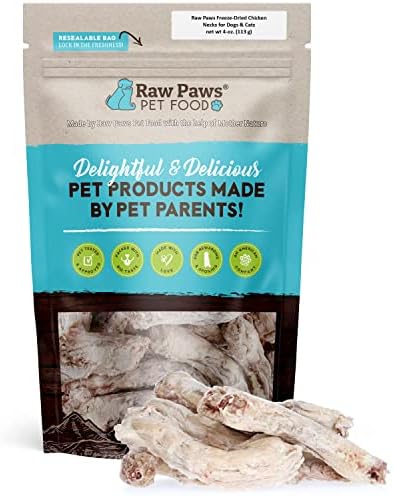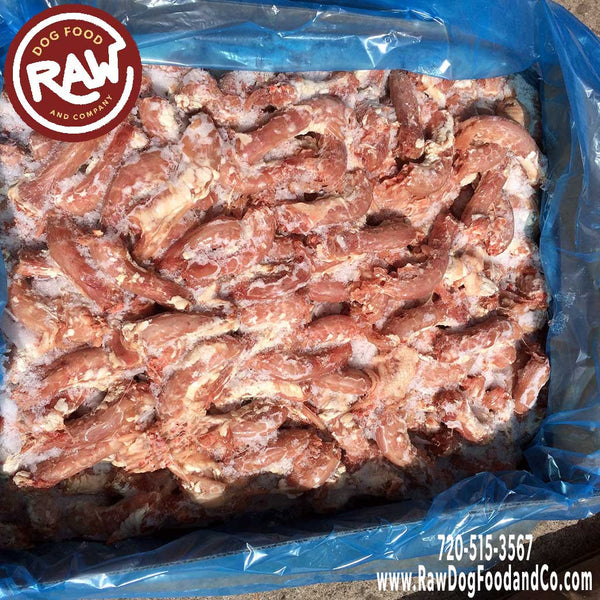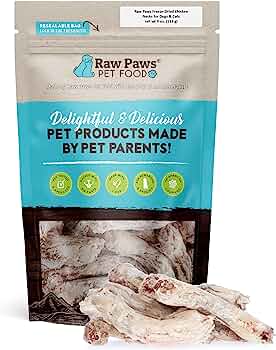What Are Chicken Necks For Dogs?

Chicken necks are a type of raw food that can be fed to dogs as part of their diet. These small, bone-in cuts of chicken provide a natural source of protein, essential fatty acids, and important nutrients like calcium and phosphorus. Chicken necks are often used as a chew treat for dogs, as the bone helps to clean their teeth and promote dental health. It is important to ensure that chicken necks are sourced from reputable suppliers and properly prepared to minimize any potential risks associated with feeding bones to dogs.
What Nutrients Do Chicken Necks Provide For Dogs?
Chicken necks provide dogs with a range of important nutrients. They are an excellent source of protein, which is essential for building and repairing tissues in the body. Additionally, chicken necks contain essential fatty acids that support a healthy coat and skin. They are also rich in calcium and phosphorus, which are vital for strong bones and teeth. These nutrients contribute to overall canine health and well-being. Feeding chicken necks as part of a balanced diet can help ensure that your dog receives the necessary nutrients for optimal health.
Are Chicken Necks Safe For Dogs To Eat?
Chicken necks can be safe for dogs to eat, as long as certain precautions are taken. One of the main concerns with chicken necks is the potential choking hazard they pose, especially if the neck is too large for the dog to chew properly. It is important to choose necks that are appropriate for your dog’s size and chewing ability. Additionally, it is crucial to supervise your dog while they are eating to prevent any accidents. If you have any concerns or questions about feeding chicken necks to your dog, it is always best to consult with your veterinarian for personalized advice.
Health Benefits Of Chicken Necks For Dogs

Chicken necks offer several health benefits for dogs. They are rich in protein, which is essential for muscle development and repair. Additionally, chicken necks contain chondroitin and glucosamine, natural compounds that support joint health and mobility in dogs. These nutrients can help improve your dog’s joint function and alleviate symptoms of joint-related conditions such as arthritis. Furthermore, the act of chewing on chicken necks can help promote dental health by naturally cleaning your dog’s teeth and preventing the buildup of plaque and tartar.
Improving Dental Health With Chicken Necks
Chicken necks provide a natural and effective way to improve dental health in dogs. Chewing on chicken necks helps remove plaque and tartar from your dog’s teeth, promoting good oral hygiene. The act of gnawing on the necks also stimulates saliva production, which can help wash away bacteria and food particles that may lead to dental issues. The texture of the necks helps to scrape off buildup on the teeth, reducing the risk of tooth decay and gum disease. Regularly including chicken necks in your dog’s diet can contribute to their overall dental well-being.
Supporting Joint Health And Mobility In Dogs
Chicken necks for dogs can also play a role in supporting joint health and mobility. These necks are naturally high in chondroitin and glucosamine, which are important components for maintaining healthy joints. Chondroitin helps to improve joint flexibility and reduce inflammation, while glucosamine helps to repair and rebuild cartilage. Including chicken necks in your dog’s diet can provide these essential nutrients, promoting strong and mobile joints. However, it’s important to note that chicken necks should be served in moderation and as part of a balanced diet to avoid any potential risks or imbalances.
Risks And Considerations Of Feeding Chicken Necks

Feeding chicken necks to dogs can come with certain risks and considerations that need to be taken into account. These include the potential choking hazards and the presence of bones in chicken necks, which can pose a threat to a dog’s safety. Additionally, some dogs may have allergies or sensitivities to chicken, which could lead to adverse reactions. It’s important to carefully supervise dogs while they are eating chicken necks and to properly prepare and serve them in appropriate portion sizes. Consulting with a veterinarian can provide further guidance and recommendations for your dog’s specific dietary needs.
Choking Hazards And Bones In Chicken Necks
Choking hazards and the presence of bones in chicken necks are important considerations when feeding them to dogs. Chicken necks contain bones that can pose a choking risk or cause intestinal blockages if swallowed whole. It is crucial to carefully supervise your dog while they are eating chicken necks and to choose an appropriate neck size that matches their chewing ability. Taking these precautions can help ensure your dog’s safety and prevent any potential choking incidents or digestive issues.
Potential Allergies And Sensitivities To Chicken Necks
Chicken necks, like any other food, can potentially cause allergies or sensitivities in some dogs. Dogs can develop allergic reactions to proteins in chicken, such as histamine reactions, gastrointestinal upset, or skin irritations. Additionally, dogs with known poultry allergies should avoid chicken necks altogether. It is important to monitor your dog closely for any signs of allergic reactions or sensitivities when introducing chicken necks into their diet. If you suspect your dog may have an allergy or sensitivity, consult with your veterinarian for guidance on alternative protein sources and suitable diets for your furry friend.
How To Safely Feed Chicken Necks To Dogs

When feeding chicken necks to dogs, it is important to ensure their safety and proper handling. Here are some guidelines to safely feed chicken necks to dogs:
- Cooked or Raw: Depending on your dog’s preference and tolerance, you can feed them either cooked or raw chicken necks. However, make sure to remove any excess fat or skin.
- Serving Size: Consider the size and breed of your dog when determining the appropriate serving size. A general guideline is to offer one chicken neck per day for small to medium-sized dogs, and two chicken necks for larger breeds.
- Supervision: Always supervise your dog while they are eating chicken necks to prevent choking or any other mishaps. Some dogs may try to gulp the necks without properly chewing, so it is crucial to monitor them closely.
- Feeding Method: You can serve the chicken necks as a standalone treat, or you can include them as part of your dog’s regular meal. You can also engage them in mentally stimulating activities, such as using them as a reward during training sessions.
Remember, every dog is unique, and it is essential to observe your dog’s behavior and digestion when introducing chicken necks into their diet. If you notice any adverse reactions or complications, consult with your veterinarian for further guidance.
Proper Preparation And Serving Size Of Chicken Necks
To safely prepare chicken necks for your dog, it is important to remove the skin and trim off any excess fat. This helps to reduce the omega-6 fatty acids and prevent any digestive issues. Whether you choose to cook the chicken necks or serve them raw, always ensure they are thoroughly cooked or handled properly. When determining the serving size, consider your dog’s size and breed. Generally, one chicken neck per day is suitable for small to medium-sized dogs, while larger breeds may benefit from two chicken necks. Always consult with your veterinarian for personalized serving recommendations.
Supervision And Monitoring While Feeding Chicken Necks
Supervision and monitoring are essential when feeding chicken necks to dogs. It is important to stay present and observe your dog while they are eating to ensure their safety. Keep an eye out for any signs of choking or discomfort. Additionally, consider the size of the chicken necks and match them to your dog’s chewing ability. If your dog is a fast eater or tends to gulp their food, it may be wise to cut the chicken neck into smaller pieces to reduce the risk of choking. By closely supervising and monitoring your dog, you can prevent any potential hazards and ensure a safe feeding experience.
Alternatives To Chicken Necks For Canine Nutrition

When it comes to providing a balanced diet for your dog, there are several alternatives to chicken necks that can offer similar nutritional benefits. Some options include:
- Chicken Breast: This lean protein source is low in fat and easily digestible for dogs.
- Turkey Necks: These provide a similar chewing experience and are rich in protein.
- Beef Ribs or Marrow Bones: These can help promote dental health and provide a source of calcium.
- Fish: Incorporating fish into your dog’s diet can provide omega-3 fatty acids and support a healthy coat and skin.
- Organ Meats: Liver, kidney, and heart are nutrient-dense and can be included in your dog’s diet in moderation.
Remember to consult with your veterinarian to ensure you’re providing a well-rounded and balanced diet for your furry friend.
Exploring Other Protein Sources For Dogs
There are several protein sources that can be beneficial for dogs in addition to chicken necks. Turkey, beef, marrow, lamb, pork, duck necks, rabbit ears, and fish are all great alternatives that provide essential nutrients and protein. These protein sources can be incorporated into your dog’s diet to ensure a well-rounded nutritional profile. It is important to choose high-quality sources and vary the proteins to provide a wide range of nutrients. Remember to consult with your veterinarian to determine the best options for your dog’s specific needs.
Balancing Your Dog’s Diet With Variety And Supplements
To ensure that your dog’s diet is well-balanced, it’s important to incorporate variety and consider supplements. Offering a range of protein sources such as turkey, beef, lamb, and fish can provide different nutrients and prevent your dog from developing allergies or sensitivities. Additionally, you can add supplements like omega-3 fatty acids, probiotics, and multivitamins to ensure they receive all the necessary nutrients. Remember to consult with your veterinarian to determine the right balance of variety and supplements specific to your dog’s needs.
Conclusion

In conclusion, chicken necks can be a beneficial addition to a dog’s diet when properly prepared and incorporated into a balanced feeding plan. They provide a rich source of protein, aiding in muscle growth and overall canine health. However, it is important to consider the potential risks, such as choking hazards and allergies. Consulting with a veterinarian or canine nutritionist is essential to ensure that chicken necks are introduced safely and in appropriate quantities. Remember to always prioritize variety and consider supplements to maintain a well-rounded and nutritious diet for your furry companion.
Key Takeaways On Feeding Chicken Necks To Dogs
Feeding chicken necks to dogs can provide various health benefits, including improved dental health and support for joint health and mobility. However, there are risks to consider, such as choking hazards and potential allergies. It is crucial to properly prepare the chicken necks and supervise the dog while eating them. Consulting with a veterinarian or canine nutritionist is essential to ensure that chicken necks are introduced safely and in appropriate quantities. Remember to prioritize variety in your dog’s diet and consider supplements to maintain a well-rounded and nutritious feeding plan.
Consulting With Veterinarians For Dietary Recommendations
When it comes to your dog’s diet, it is always best to consult with a veterinarian for personalized dietary recommendations. Veterinarians are knowledgeable about canine nutrition and can provide guidance on whether chicken necks are suitable for your dog and how they should be incorporated into their diet. They can take into consideration factors such as your dog’s age, breed, size, and any underlying health conditions to ensure that their nutritional needs are being met. By consulting with a veterinarian, you can ensure that you are making informed decisions about your dog’s diet and promoting their overall health and well-being.
FAQ About Chicken Necks For Dogs: Understanding Pet Nutrition
Q: What are the benefits of feeding chicken necks to dogs?
A: Chicken necks are a good source of protein, essential fatty acids, vitamins, and minerals. They also aid in dental health by helping to clean teeth and strengthen gums.
Q: How should chicken necks be served to dogs?
A: Chicken necks should be raw and served in small pieces to prevent choking. It’s important to supervise your dog while they are eating to ensure they are chewing the necks properly.
Q: Are there any risks associated with feeding chicken necks to dogs?
A: Chicken necks can be a choking hazard if not served in appropriate sizes. They should also be fed in moderation to avoid an unbalanced diet. Consult with your veterinarian before introducing new foods to your dog’s diet.
Q: Can all dogs eat chicken necks?
A: While most dogs can safely consume chicken necks, it’s essential to consider your dog’s individual health needs and any dietary restrictions they may have. Dogs with certain health conditions or allergies may not be suitable for chicken neck consumption.
Q: How often can chicken necks be included in a dog’s diet?
A: It’s recommended to include chicken necks as an occasional treat rather than a staple in your dog’s diet. Balance is key, so ensure your dog is receiving a well-rounded and nutritious diet overall.

Hot Pot Chinese Restaurant, located in Mechanicsville, MD 20659, is a culinary destination that offers a delightful array of Chinese cuisine. From the cozy ambiance to the delectable dishes, Hot Pot Chinese Restaurant is dedicated to providing an exceptional dining experience for all patrons. Since our establishment, Hot Pot Chinese Restaurant has been committed to serving the finest Chinese food, offering a diverse menu that caters to a wide range of tastes. Whether you’re craving traditional favorites like Kung Pao Chicken and Mongolian Beef or seeking out more adventurous options like Szechuan Spicy Hot Pot, our menu has something to satisfy every craving.